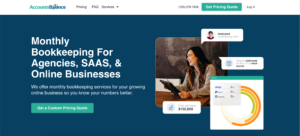
Want to learn about the SAAS revenue model?
It’s one of the most popular business types on the Internet today.
My name is Connor Gillivan. I’m a 10+ year Entrepreneur.
I’ve scaled multiple companies to 6, 7, and 8 figures with an exit in 2019.
In this article, we’ll break down the SAAS revenue model so you have a full understanding of how it works.
Here’s what we’ll cover:
- What Is the SAAS Revenue Model?
- Why Are SAAS Businesses So Popular?
- What Are Different SAAS Pricing Models?
- SAAS Revenue Model Examples
- Potential Cons of the SAAS Revenue Model
- 5 Tips For Managing Your SAAS Financials
- Best Tools For Collecting Revenue for SAAS Businesses
What Is the SAAS Revenue Model?
The SAAS (Software as a Service) revenue model is a model in which software companies charge customers a recurring fee for access to their software, typically on a monthly or annual basis.
This revenue model differs from the traditional software model, where customers would pay a one-time fee for a license to use the software.
Why Are SAAS Businesses So Popular?
There’s a lot to like about the SAAS business and revenue model:
- Cost-effectiveness: SAAS businesses provide customers with a cost-effective solution to their software needs by eliminating the need for expensive upfront investments in software licenses and infrastructure. Customers only pay for what they use on a subscription basis.
- Scalability: SAAS businesses are highly scalable, allowing them to easily accommodate growing businesses without requiring significant investment in additional hardware or software.
- Accessibility: SAAS businesses are accessible to anyone with an internet connection, which means that they are available to individuals and businesses all over the world, regardless of location or size.
- Predictable revenue stream: SAAS businesses typically generate a recurring stream of revenue, which makes it easier to predict and plan for growth.
- Continuous improvement: SAAS businesses are constantly improving their products based on customer feedback, which ensures that they are always up-to-date and able to meet the changing needs of their customers.
- Integration: SAAS businesses can integrate with other software systems, making it easier for customers to manage their business processes and workflows.
- Data security: SAAS businesses typically have strong data security measures in place, which can help protect sensitive customer data and provide peace of mind to customers.
- Flexible pricing models: SAAS businesses often offer a variety of pricing models to meet the needs of different customers, including pay-as-you-go, annual subscriptions, and usage-based pricing.
- Ease of use: SAAS businesses are typically designed to be user-friendly and intuitive, which reduces the need for extensive training and support.
What Are Different SAAS Pricing Models?

Pricing for SAAS businesses can vary. Here are 7 options to consider:
- Monthly Subscription: In this pricing model, customers pay a recurring fee each month to access the SAAS product. This model provides a predictable revenue stream for the SAAS company and allows customers to pay only for the time that they use the product.
- Annual Subscription: Similar to the monthly subscription model, customers pay a recurring fee each year to access the SAAS product. This model often includes a discount for customers who commit to a longer-term subscription, which can be beneficial for both the customer and the SAAS company.
- Pay-As-You-Go: In this pricing model, customers only pay for what they use, based on the volume of usage or the number of transactions. This model can be beneficial for customers who have variable usage patterns or for SAAS products that are used infrequently.
- Usage-Based Pricing: This pricing model charges customers based on the amount of usage, typically in terms of API calls or data usage. This model can be beneficial for SAAS companies that offer data-intensive services or have customers with varying levels of usage.
- Freemium: In the freemium pricing model, the basic version of the SAAS product is offered for free, but users are required to pay for additional features or functionality. This model can be an effective way to attract new customers and build brand awareness, but it can be challenging to convert free users into paying customers.
- Tiered Pricing: This pricing model offers different levels of service at different price points, with each tier providing additional features or functionality. This model can be beneficial for SAAS companies that serve customers with varying needs and budgets.
- Per-User Pricing: In this pricing model, customers pay based on the number of users who access the SAAS product. This model can be beneficial for SAAS products that are used by teams or organizations, as it allows for better alignment between the cost of the product and the value that it provides.
SAAS Revenue Model Examples
Here are 4 examples of real companies that utilize the SAAS revenue model:
- Dropbox: Dropbox is a cloud storage SAAS product that uses the monthly subscription pricing model. Customers can choose from a variety of plans, each with a different amount of storage and features. Customers pay a monthly fee to access their files and can easily upgrade or downgrade their plan as their needs change. Dropbox’s predictable revenue stream allows them to invest in product development and customer support, while their scalable infrastructure allows them to accommodate businesses of all sizes.
- HubSpot: HubSpot is a marketing automation SAAS product that uses the freemium pricing model. Customers can use the basic version of the product for free, but are required to pay for additional features and functionality, such as advanced analytics and automation workflows. HubSpot’s freemium model has been effective in attracting new customers and building brand awareness, with many customers upgrading to paid plans as they see the value that the product provides. Additionally, HubSpot’s flexible pricing model, which includes monthly and annual subscriptions, allows customers to choose the plan that best fits their budget and needs.
- Amazon Web Services (AWS): AWS is a cloud computing SAAS product that uses the usage-based pricing model. Customers only pay for what they use, based on the volume of usage or the number of transactions. This model can be beneficial for customers who have variable usage patterns or for SAAS products that are used infrequently. AWS’s usage-based pricing allows them to attract customers who require flexible computing resources and who may not want to commit to a fixed monthly or annual fee. Additionally, AWS’s pricing model is designed to scale with the needs of their customers, making it an attractive option for businesses of all sizes.
- Salesforce: Salesforce is a customer relationship management (CRM) SAAS product that uses the per-user pricing model. Customers pay based on the number of users who access the SAAS product, with each user having access to a range of features and functionality. This model can be beneficial for SAAS products that are used by teams or organizations, as it allows for better alignment between the cost of the product and the value that it provides. Salesforce’s per-user pricing model allows them to provide a flexible and scalable CRM solution that can meet the needs of businesses of all sizes. Additionally, Salesforce’s pricing model is designed to encourage user adoption, with additional users adding value to the product and increasing the revenue for the company.
Potential Cons of the SAAS Revenue Model

While SAAS business models are extremely popular and offer a lot of potential Pros, there are also some cons to consider:
- Churn: SAAS businesses rely heavily on recurring revenue, so customer churn can be a major concern. If customers are not satisfied with the product or if they find a better alternative, they may cancel their subscription, leading to a loss of revenue for the SAAS business.
- Pricing pressure: The SAAS market is highly competitive, and customers may be hesitant to pay premium prices for a SAAS product. This can put pressure on SAAS businesses to keep their prices low, which can impact profitability and limit their ability to invest in product development and customer support.
- Customer acquisition costs: Acquiring new customers can be expensive for SAAS businesses, particularly those that are just starting out. Advertising, marketing, and sales expenses can quickly add up, making it difficult for SAAS businesses to achieve profitability.
- Technical challenges: SAAS businesses require sophisticated technical infrastructure and support to deliver a reliable and scalable product to their customers. This can be challenging and expensive to build and maintain, particularly for smaller SAAS businesses with limited resources.
- Dependence on third-party platforms: Many SAAS businesses rely on third-party platforms, such as payment processors, cloud hosting providers, and marketing automation tools. This can create a dependence on these platforms, which can be problematic if there are technical issues or if the cost of these services increases.
5 Tips For Managing Your SAAS Financials

Keep these 5 tips in mind while scaling your SAAS business:
- Establish a clear financial plan: It’s important to establish a financial plan that outlines your revenue goals, expenses, and cash flow projections. This plan should be revisited and updated regularly to ensure that you are staying on track and making informed financial decisions. Download this free Monthly Finance Meeting Agenda.
- Track key performance indicators (KPIs): There are several key performance indicators that are particularly relevant for SAAS businesses, such as customer acquisition cost (CAC), lifetime value (LTV), churn rate, and monthly recurring revenue (MRR). By tracking these KPIs, you can better understand your business’s financial performance and make data-driven decisions.
- Manage your expenses carefully: SAAS businesses have a wide range of expenses, including salaries, marketing, infrastructure, and third-party services. It’s important to manage these expenses carefully and prioritize investments that will have the greatest impact on your business’s growth and profitability.
- Plan for growth and scalability: SAAS businesses can experience rapid growth, which can put pressure on their financial and technical infrastructure. It’s important to plan for growth and scalability from the outset, so that your business can meet the demands of an expanding customer base.
- Seek professional advice when needed: Managing your SAAS financials can be complex and challenging, particularly if you don’t have a background in finance or accounting. Consider seeking professional advice when needed, such as from a financial advisor or accountant, to ensure that you are making informed financial decisions and managing your finances effectively.
Best Tools For Collecting Revenue for SAAS Businesses
Choosing a reliable software tool for collecting revenue from your SAAS customers is a key decision.
Here are 4 SAAS software tools to consider:
- Stripe: Stripe is a popular payment processing platform that is used by many SAAS businesses. It offers a range of features and integrations, such as support for multiple currencies, subscription management, and fraud detection.
- PayPal: PayPal is another well-known payment processing platform that can be used by SAAS businesses. It offers a range of features, such as support for multiple payment types, invoicing, and integration with popular ecommerce platforms.
- Chargebee: Chargebee is a subscription billing and management platform that is designed specifically for SAAS businesses. It offers features such as subscription management, billing automation, and revenue recognition.
- Recurly: Recurly is another subscription billing and management platform that is popular among SAAS businesses. It offers features such as subscription management, billing automation, and integrations with popular payment gateways.
What Is AccountsBalance?

AccountsBalance is a monthly bookkeeping service specialized for agencies & SAAS companies.
We take monthly bookkeeping off your plate and deliver you your financial statements by the 15th or 20th of each month.
You’ll have your Profit and Loss Statement, Balance Sheet, and Cash Flow Statement ready for analysis each month so you and your business partners can make better business decisions.
Interested in learning more? Schedule a call with our CEO, Nathan Hirsch.
And here’s some free resources:
In Summary
The SAAS revenue model has a LOT of pro’s.
If you’re a software developer with a great idea, you’ve got a lot of excitement ahead of you.
Or if you’re an Entrepreneur with a great software idea, the SAAS business model is a great fit.
If you still have questions about SAAS companies, reach out to us at [email protected].
Cheers!









